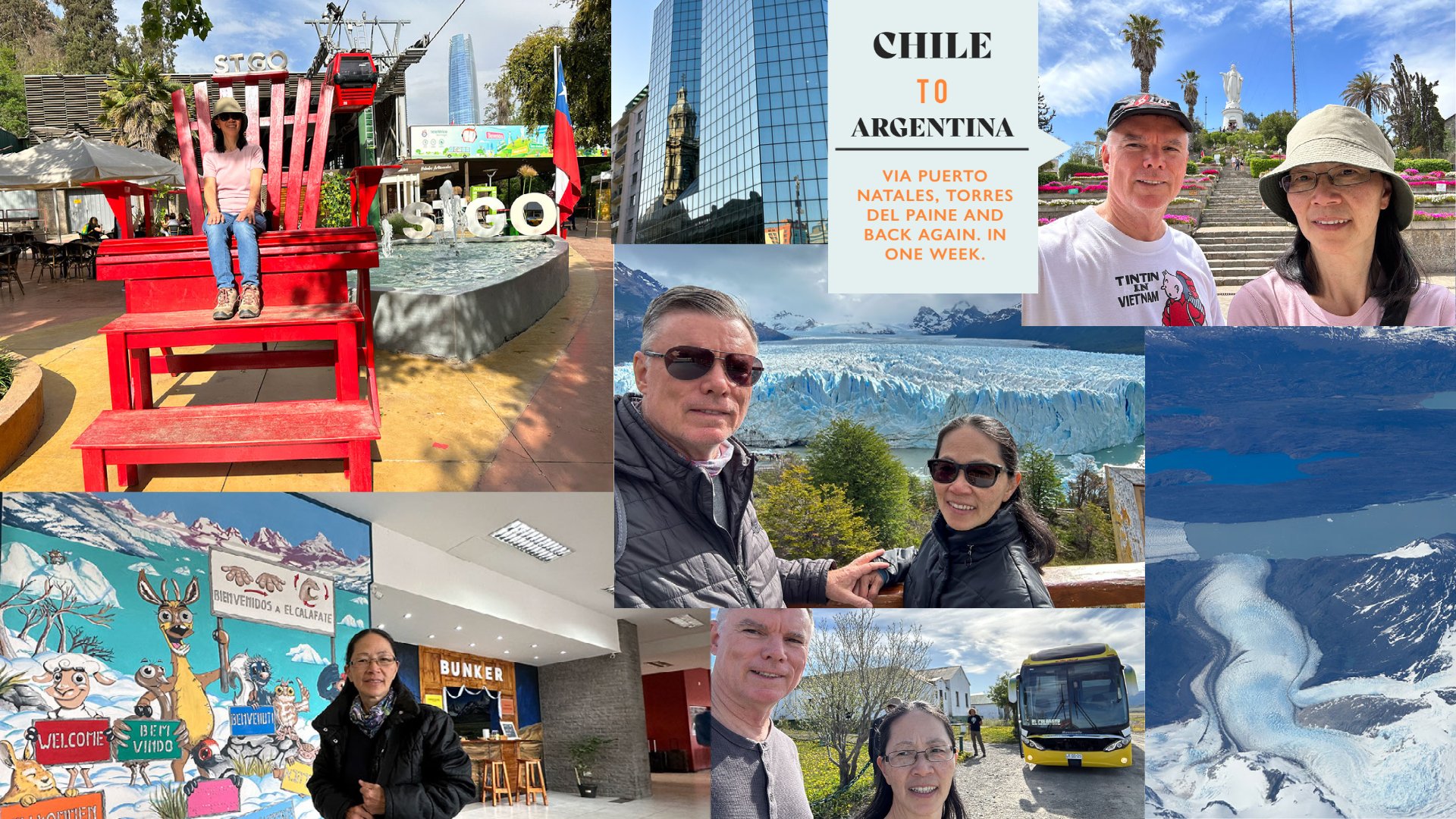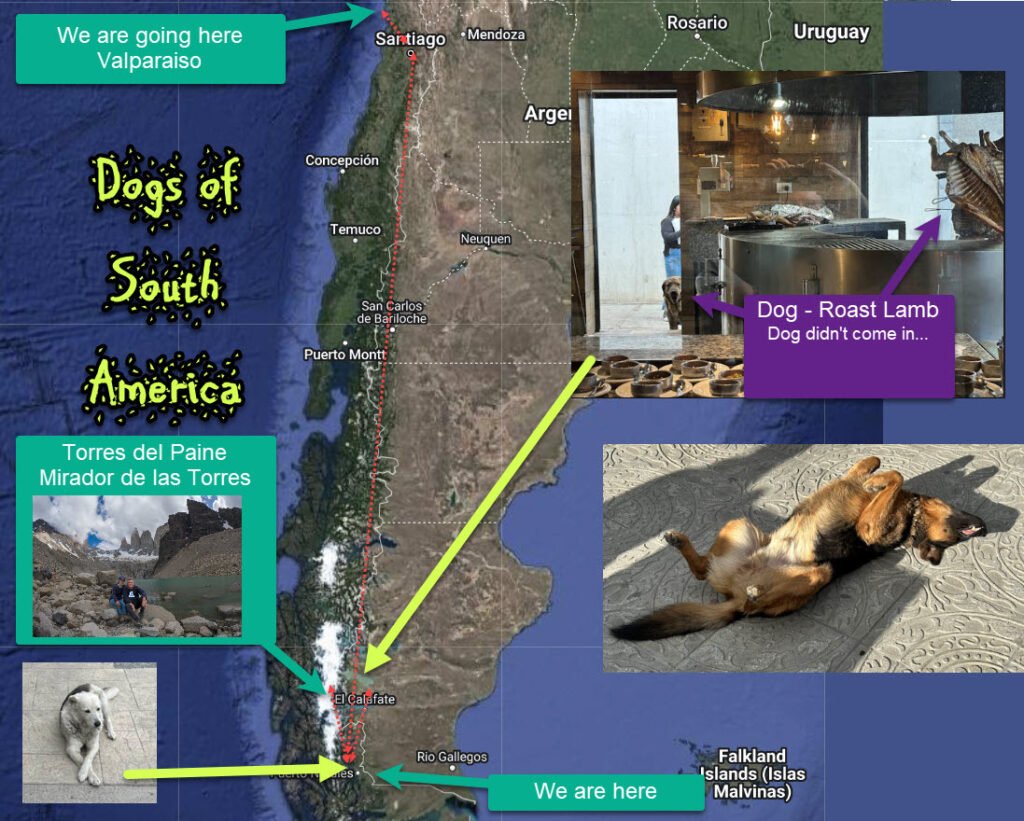Chile to Argentina and back. Whew – What a week (actually two)!

It has taken me longer to post this than expected. However, guilt levels are quite low given the amount of action we have seen. The title should probably read “From Santiago to Santiago to Santiago via Argentina in two weeks” which is more accurate because we will have arrived in Santiago three times in two weeks by the time this is posted.

Our son Joe was kind enough to drop us off at a rather early hour at Tullamarine Airport in Melbourne so we could catch the 6am flight from Melbourne to Sydney.

Lounges, plane trips, service, customs, immigration, transit and all those things we encounter when travelling are something for another time. Bottom line is that our journey from Darwin to Santiago via Melbourne, Sydney and Auckland went smoothly and was a pleasure.
Even by my standards, the first week in South America was a full-on week right from the point we landed in Santiago. With no Spanish language skills to speak of and no experience in Latin America, we knew we were going to be like a fish out of water. Even getting to the bus that takes us to the metro which would eventually take us to our Airbnb turned what would normally be a 20-minute Uber ride into Santiago ended up taking us 2 hours.
Credit Card Lost before we leave Santiago Airport
The excitement began when we went to withdraw some money from an ATM machine. This was at the airport. I had completed my customs declaration which in Chile is referred to as a SAG form. I felt I needed to declare my single serve of Vegemite.

After proceeding through the red channel without any problems. We made our way to an ATM machine which as it turns out. Luckily was connected to a bank with a person working inside. We went through with a few trial and error attempts at withdrawing money (there is a button in the bottom left of the ATM button options which is for foreigners) and when we managed to withdraw the money, there is a prompt that asks “do you wish to conduct another transaction?” I don’t think I saw that. We collected the money and receipt, counted and calculated everything and walked away from the machine completely forgetting about the card.
The machine smartly realised that we walked away with the card still in the machine and promptly swallowed the card.
So we hadn’t even been in Chile for half an hour or exited the airport and I had already lost our credit card (that is why you should carry a backup card). I saw some movement inside the locked glass door adjacent to the ATM machine. Fortunately, the gentleman responded and even more fortunately he spoke English and understood our plight. After a little verification, my credit card was passed back through the crack in the glass doors, much to the relief of myself and Helen.
Prior to that, our path through immigration and customs was without event and just with carry on baggage, we were through a rather deserted international arrival section into the expected gathering of taxi drivers looking for a fare.
We try the public transport system with zero language and zero internet or paper maps
We knew we wanted to try and use public transport to get to our accommodation in the city which consisted of catching a bus from the airport and transferring to the metro for the next leg.
Not having bought a SIM card at the airport, we were without internet, but I had downloaded Microsoft Translator and the offline Spanish language pack, but I hadn’t really played around with it and found that I was tapping on the wrong icons when I needed to translate something.
Having a script ready that runs along the lines of:
- Two bus tickets one way to Parajitos station
- Is the next stop Parajitos station?
- Is this Parajitos station?
- Two metro tickets to Santiago Central Station
Having these phrases ready to go might have cut down our time spent struggling with explanations which by the time we worked everything out was a great experience. The simple phrase and action of “catch public transport to the city” becomes an adventure when you are a stranger in a strange land.
I want to highlight the relaxed, calm patience demonstrated by the public transport officials and shop owners who encountered the 2 of us on our journey from the airport using the bus and Metro train to get to our air Airbnb destination. In 2 cases, we returned to 2 people at the Metro train ticketing and access area to work out how to buy the Metro ticket and then catch trains on the 2 lines require to get us into central Santiago.
Once we had worked it out, it was very easy. The working out part took maybe half an hour. During that time the 2 ladies assisting us who worked for the public transport system demonstrated patience with a smile. Thank you, Chile.
For subsequent trips, we took screen captures of the bus company, route, and connection location and saved them as images into our travel Microsoft Onenote and then made sure that page was synchronised to our phone. If you just live off your phone, screen capture the website page with the information you need and save it in your camera roll or into Notes (I am an iPhone user). Do the same for routes on maps if you don’t have a signal.
If you are travelling as a couple, you only need to buy a single travel card and tap twice when through the departure barriers and again tap twice when you exit at the other end.
Getting a SIM card
That turned out to be easy. In the centre of Santiago and I suspect everywhere is a small stall or concession selling sim cards. The first sim card cost us 2000 pesos or about $3.50 Australian for 7 days and 2 gig of data. Using Whatsapp and connecting the phone number of the sim card is the way to go because there is a real phone number and you can also use chat (with translation) to converse with folks. I am not a big whatsapp user, but when in Chile…
After putting the sim card into the phone, I think but am not too sure, that I had to make a phone call to anyone or any (local Chilean) number to trigger the card data. We were trying to get the access code to the property we were staying at and honestly between the SMS messages from the card provider and conversing via the translator app with the concierge/security gentleman in the massive 3-tower condominium complex we were staying in I am not too sure what triggered the sim card to start working, but it did.
We did do a little research and Movistar is probably the best in terms of prepaid mobile plans – coverage and cost. It didn’t work for us when we crossed the border into Argentina, but that was to be expected.
What is easier is recharging the card online. There is a third-party company that pops up in the search engines when you go to recharge your Movistar or any rechargeable sim card. Of course, they clip the ticket and a 1000 peso recharge costs 1350 or thereabouts. Finding the URL to recharge directly with Movistar was a bit of a challenge and then using an e-commerce platform that accepts your card. This was where our ING card let us down as it wasn’t accepted when we entered the details to pay.
The Revolut card though was able to be used. I had only signed up for one as an experiment and it only had 10 dollars on it. We have now used this Revolut card for a couple of transactions where the ING card doesn’t work.
In 2013 we went around the US without a sim card or mobile data, relying on being WiFi bandits. We have done the same in the primarily Asian countries we have visited over the last two decades. Nowadays though, I think that time has passed.
Power plug adaptor
We had purchased two adaptors, one with a US-style plug for Columbia and a rounded two-pronged European plug which I thought was the plug also used in Chile. Wrong. The plug is two-pronged and rounded, but thinner. It is in fact the same as what we use in Indonesia and a number of other Asian countries.
Fortunately, it was very easy to find a shop and tolerant owner who sold us a multi-function adaptor that will see us around South America and Europe.
We are using the laptop with USB ports to charge multiple items, but having two of these adaptors would be better.
Let’s start looking now we have the basics sorted
After our slight stumbling start described above, we managed to get to our Airbnb. After settling in, we took a walk down to Plaza de Armos.
The button below takes you to the static album of the slideshow below.

There are a number of very impressive buildings surrounding the square. This one is the Santiago Metropolitan Cathedral. The construction of this neoclassical Cathedral began in 1753 and concluded in 1799. The style of this Cathedral is Baroque with many ornaments, frescoes and gilded columns. The 2 towers that you see in the photograph were added almost a century after the cathedral was built. One of the challenges of this kind of building is that Chile is very prone to earthquakes and buildings made from stone like this one are prone to earthquake damage.
The Plaza itself is resplendent with a number of palm trees that look like Cuban Royal Palms. A vibrant gathering area for local citizens, It added a level of energy to a couple of tired travellers who had just arrived from Australia.
One of the many ground plaques that are around the Plaza is one identified as “kilometre zero” of Santiago. That marks Santiago’s zero point from where other distances can be calculated and is a standard marker in many cities. One particular image I captured reflects (pun intended) the blending of modern and classical architecture. I think many countries and cultures want to have old and new (insert what your definition of old and new might be here) coexisting but as with this picture, maybe a reflection of the old in the new, indicating that is the way forward.
I have realised that I haven’t even completed the first night in Santiago and I must press publish at some point in time.
We returned to our apartment despite being wide awake in an attempt to adjust to the time zone and be up early the next day for a Santiago Stroll.
Day 2 in Santiago
The next day we first visited the nearby hill Cerro Santa Lucia. There were many buildings, gardens and monuments located within this extensive inner city park. From there we made our way past an old fire engine (we also photographed a working fire engine in Valparaiso) to the National Museum of Fine Arts. Then we made our way through the Bellavista area of the city to the base of the Funicular Tram which took us up to the Lady of Immaculate Conception Statue and Park. From there we took the Cable Car to one of the tallest buildings in the Southern Hemisphere and certainly the tallest in Chile, Gran Torre Santiago (and Jumbo Supermarket). After wandering and shopping we did the reverse trip in the cable car and tram back to our apartment. By taking a slightly different path we wandered down a wonderful bohemian street filled with art, entertainment locations and interesting people.
Day 3 in Santiago
We took the metro using our bip card which is like a myki card if you are from Melbourne. Once you have the card, you can top up at the station, purchasing just what you need for your journey. The metro travel card used in Vina del mar and Valparaiso is different to the bip card in Santiago. We visited a very large shopping mall and from there walked to bicentennial park before making our way again to Gran Torre Santiago. Back on the metro and we packed up for our big journey to Puerto Natales and then onto El Calafate in Argentina to view the glacier at Perito Moreno.
From Santiago Chile to El Calafate Argentina via Puerto Natales
We had a big journey ahead of us to get from Santiago to El Calafate.
We had purposely requested a multi-entry visa so we could go down south to Patagonia, pop across the border to visit the Perito Moreno glacier in Argentina and then return to trek through Torres del Paine. In coordinating flights and busses, it looked like we could arrive in the afternoon on our flight with SKY airlines and then transfer to a coach to get to El Calafate. Both the SKY airlines return air tickets and the coach tickets were booked online without much issue. We used “gotogate” to book the tickets. They are connected with “Rome2Rio” which has helped us map out trips with connections. While not perfect, it really assists with preplanning.
We purposely arrived early as we were not familiar with the check-in system
Our flight to Puerto Natales left at 8:30 am and public transport would not get us there in time, despite us now being black belts with the bip card and public transport. We took an uber which was easy to book and cost 17000 pesos from the centre of Santiago to the airport. The cost for the ride was 30 AUD for a ride distance similar to our house in Melbourne to the airport. The same Uber ride there costs 45 to 60 dollars AUD. It was easy, clean and with no stress. I want to add that the coaches to and from the airport as well as the metro are also very clean.
The weigh-in police we are used to when travelling light with Jetstar in Australia were nowhere to be seen despite documentation warning of severe penalties for travelling with something more than a really small bag. We were prepared, paid for check-in baggage and shuffled our luggage around, making use of our two pocket day backpacks which handle the gear we were not prepared to lose.
We took some photos of what folks were carrying on and it amazed us what was allowed on as cabin baggage.
Getting our boarding pass was easy and I mention that because some of the apps for things like airlines are only available in the Chile app store. They should be made available worldwide so folks from overseas can download them without having to set up another iTunes account for the Chile store. I didn’t.
The flight was great and there were some awesome views out of the window as we approached Puerto Natales. Check out Grey Glacier in the album below. It was so cool to get a birdseye view of what we were going to visit.
Landed in the nice small airport of Puerto Natales and on the walk from the plane across the tarmac we were treated to some of the best views I have ever seen after getting off an aeroplane. Collected our bag which we probably didn’t need to check in and noticed already there was a rip in the corner of the Caribee Skymaster backpack. Probably another reason to not check-in baggage. Another rip occurred on the trip back from Puerto Natales to Santiago.
Bag collected, onto the shuttle which costs 4000 per person (about 5 AUD) and we were off to Puerto Natales. If you are a couple, a taxi into the centre of town costs 8500 so your call. We went straight to the bus station where we collected our bus tickets and went upstairs to the Cafeteria for lunch. Katerina was our host and her English was great. She had some good tips and suggestions for us.
We had checked bus timetables and by connecting to a bus that would take us on the five-hour journey across the border into Argentina and to El Calafate, we would save an extra night.
Due to the daylight hours being longer, we were treated to the scenery of the Patagonian steppe as we made our way across the border and into Argentina.
Along the way, we were on roads taking us through the Patagonian Steppe and not up into any high mountainous areas or through forested areas. Before we knew it on our five-hour bus journey, we were at the Chilean border crossing where we showed our passports, visas and arrival docket provided by Immigration on arrival.
The folks at the border crossing (Paso Rio Don Guillermo) stamped our exit from Chile and took the arrival document. We have a multiple entry visa which cost the same as the single entry visa and I am glad we opted for it because it provides greater flexibility with trips down and around the Chilean and Argentinian border areas in Patagonia and I suspect the same up in the Bolivian and Chilean borders where the Atacama desert is divided by those countries as well as Argentina.
A few kilometres further down the road we saw two of the local brush-tailed foxes called “zorro” chasing each other around on the steppe. We also saw many geese pairs. The female is brown and the larger male is white. I also glimpsed a flock of flamingos which were too far away for a clear photograph. I did try but they looked like small pink marshmallows floating above small ponds on the Patagonian steppe.
Because it is almost summer, even though we arrived after 9pm, we were treated to a great sunset.
Our Airbnb host Hugo was there to collect us. He was so helpful with running us around, collecting us from town, assisting with our needs and just being a nice guy.
In Argentina, the wallsocket plugs are the same as in Australia.
Perito Moreno Glacier
We asked about the public bus out to the glacier and Hugo mentioned that there was none. We had to take a tour. All good and I am glad we did. We went with Patagonia Chic (tour company) and Virgina was our guide – Her knowledge and English skills made the day even better.
The tours to the glacier do sell out. Given that we are early in the season, we were able to get on a tour, but when we turned up at the office the next day, we were told that the tour was not available until the next day. After a little panic and a phone call, it was confirmed that Hugo had arranged and confirmed our 11am start for a tour that went until after 7pm.
It may seem strange to think that we spent hours walking up and down looking at a large block of ice, but it was so transfixing. We were treated to two large Andean condors gliding over us as we viewed the glacier. I also managed to capture the glacier calving or dropping chunks of ice from its front area.
Stay with us as the adventure continues in El Calafate and then an ever bigger drama in Torres del Paine where we didn’t realise that the park’s rangers were on strike and beginning to block access to iconic parts of the park.
To finish of though, the happy dogs of Patagonia… there seems to be a real compassion for dogs here, even the “camp dogs” in the towns of El Calafate in Argentina and Puerto Natales in Chile. They are like polite local beggars… The last photo is a dog politely waiting outside the barbeque cooking area of the reasonably upmarket Patagonian lamb restaurant we went to in El Calafate. The white dog was here in Puerto Natales.

I created this graphic a few days ago when we were in fact in Puerto Natales. As of writing this, we are in Valporaiso.



